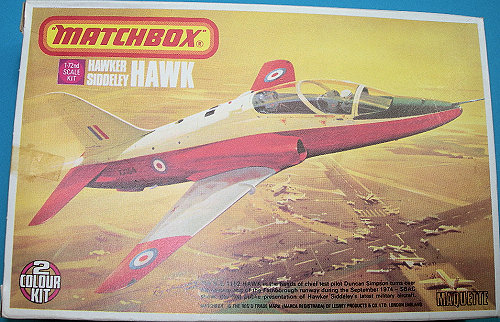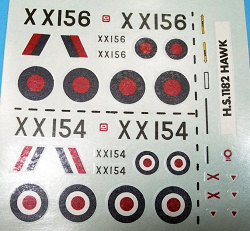
| KIT: | Matchbox 1/72 HS. 1182 Hawk |
| KIT #: | PK-27 |
| PRICE: | $ Long Out of Production |
| DECALS: | Two Options |
| REVIEWER: | Victor Scheuerman |
| NOTES: | It actually has a cockpit! |

| HISTORY |
In 1970 after a considerable amount of thinking and investigating into its requirements, the RAF suggested an outline specification for a trainer with a high subsonic performance to replace the GNAT and HUNTER and later the JET PROVOST. Both Hawker and BAC submitted designs, but after consideration the type eventually chosen was the HS 1182 now known as the HAWK; and order was placed for 175 aircraft plus one pre-production machine. Great efforts have been made to ensure that the Hawk will fill both its trainer and ground attack roles with high reliability, whilst careful design has kept the unit price to a minimum. All drawings from the outset have been to production standards. Underwing hard points are fitted and an Aden gun can be attached under the fuselage for the ground attack variant and a wide variety of bombs or rockets can be carried. 2 Martin Baker ejector seats are fitted. (Thanks to the kit instruction sheet).
While unknown at the time of the kit release, the Hawk would be a major export success and is still being produced today. Versions of the early two seat Hawk have been exported to Abu Dhabi, Kenya, Kuwait, Finland, Indonesia, Saudi Arabia, South Korea, Switzerland, Zimbabwe and with some work to the kit these all can be modelled.
| THE KIT |
 This
original boxing of the Matchbox kit is molded in dark green and taupe. As one
can expect from the English produced Matchbox kits, the moldings are clean and
free of any flash and sink marks. A total of 49 parts make up the kit and this
number includes a clear one piece canopy and the clear blast shield between the
cockpit positions. This kit has engraved panel lines only, but would look fine
after some sanding and priming with a rattle can. However, unlike a lot of these
kits, this has a rather nice cockpit that includes; a one-piece tub with a hint
of side consoles, two ejection seats, two control sticks, clear blast shield,
two very small instrument panels. With some card details and seat harnesses
added (or better yet use some after market replacements), this is one of the
better Matchbox cockpits is offered.
This
original boxing of the Matchbox kit is molded in dark green and taupe. As one
can expect from the English produced Matchbox kits, the moldings are clean and
free of any flash and sink marks. A total of 49 parts make up the kit and this
number includes a clear one piece canopy and the clear blast shield between the
cockpit positions. This kit has engraved panel lines only, but would look fine
after some sanding and priming with a rattle can. However, unlike a lot of these
kits, this has a rather nice cockpit that includes; a one-piece tub with a hint
of side consoles, two ejection seats, two control sticks, clear blast shield,
two very small instrument panels. With some card details and seat harnesses
added (or better yet use some after market replacements), this is one of the
better Matchbox cockpits is offered.
 Matchbox
offered a decent landing gear with separate retraction arms for the main gear
and nice wheel detail on all the tires. Another real plus here is that all gear
positions appear to be framed in with the nose gear too shallow which is normal
for these kits. All gear doors are too thick (normal also) and should be sanded
thinner or replaced with card. As the Hawk could also be used for weapons
training, Matra rocket pods are offered for the wing and an Aden cannon attaches
to the fuselage center line. Other nice touches are the separate wing flap
actuators and the two separate intakes on the fuselage top.
Matchbox
offered a decent landing gear with separate retraction arms for the main gear
and nice wheel detail on all the tires. Another real plus here is that all gear
positions appear to be framed in with the nose gear too shallow which is normal
for these kits. All gear doors are too thick (normal also) and should be sanded
thinner or replaced with card. As the Hawk could also be used for weapons
training, Matra rocket pods are offered for the wing and an Aden cannon attaches
to the fuselage center line. Other nice touches are the separate wing flap
actuators and the two separate intakes on the fuselage top.
Assembly is covered in nine well illustrated steps with detailed colour notes offered at the end.
Due to the fact that this kit came out pretty well as the same time as the actual aircraft, markings are limited to two separate prototypes. A rather attractive XX154 is finished with a red lower fuselage and wing tips and tailplanes, along with white upper fuselage and grey wings. A more somber XX156 is camouflaged with Dark Green and Dark Grey over Light Aircraft Grey. Most of the decals look useable except the ‘D’ roundels that are off-center.
| CONCLUSIONS |
Though this kit has been sitting on the shelf for some time, this is actually the fist close inspection that I have done. It really does looks like a great weekender blitz or something to kill a rainy day just by adding a couple of new resin seats and using some after market decals. This one is moving to the pending pile from storage!
| REFERENCES |
The Encyclopedia of Modern Warplanes, Bill Gunston, PROSPERO Books
July 2007
If you would like your product reviewed fairly and quickly by a site that has nearly 400,000 visitors a month, please contact me or see other details in the Note to Contributors.